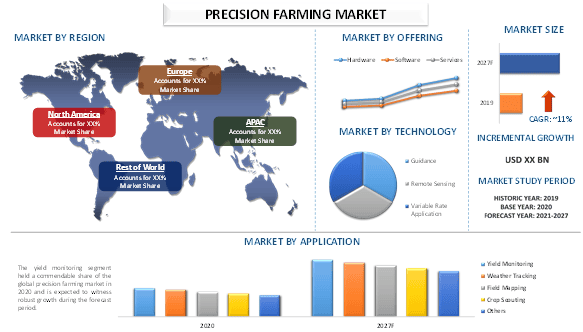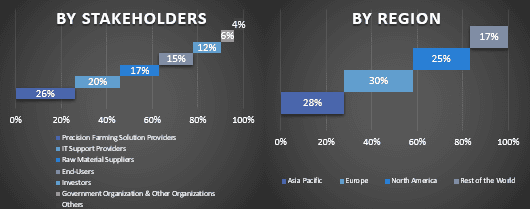- الرئيسية
- معلومات عنا
- صناعة
- الخدمات
- قراءة
- اتصل بنا
سوق الزراعة الدقيقة: التحليل الحالي والتوقعات (2021-2027)
التركيز على العرض (الأجهزة والبرامج والخدمات)؛ التكنولوجيا (التوجيه، والاستشعار عن بعد، والتطبيق متغير المعدل)؛ التطبيق (مراقبة المحاصيل، وتتبع الأحوال الجوية، ورسم خرائط الحقول، والكشف عن المحاصيل، وغيرها)؛ والمنطقة/البلد

من المتوقع أن يسجل سوق الزراعة الدقيقة العالمي معدل نمو سنوي مركب يبلغ حوالي 11٪ خلال الفترة من 2021-2027. يشهد السوق ارتفاعًا بسبب التبني السريع للتقنيات المتقدمة في الزراعة الدقيقة لتقليل تكاليف العمالة جنبًا إلى جنب مع تغير المناخ والحاجة إلى تلبية الطلب المتزايد على الغذاء. علاوة على ذلك، فإن الزيادة في تطبيق الأجهزة الذكية في الزراعة يليها الحاجة إلى التخفيف من غازات الدفيئة للحد من تغير المناخ سيحفز بشكل إيجابي المشهد الصناعي. بالإضافة إلى ذلك، فإن تزايد انبعاثات غازات الدفيئة يؤثر أيضًا على تبني الزراعة الدقيقة. على سبيل المثال، أنتج العالم 47.41 مليار طن من غازات الدفيئة في عام 2016 والتي زادت إلى 48.94 مليار طن في عام 2018. الزراعة الدقيقة هي أحدث التقنيات المستخدمة في المزارع وإدارة المزارع التي تستخدم تكنولوجيا المعلومات لضمان حصول النباتات والتربة على ما تحتاج إليه بالضبط لتحقيق الصحة والإنتاجية المثلى. الغرض من الزراعة الدقيقة هو ضمان الربحية والاستدامة وحماية البيئة.
تعتبر Deere & Company و Trimble Inc. و AGCO Corporation و AgJunction Inc. و Raven Industries Inc. و Teejet Technologies و AG Leader Technology و AgEagle Aerial Systems Inc. و Granular Inc. و CropX Inc. من بين اللاعبين الرئيسيين في السوق. وقد قامت هذه الشركات بتنفيذ العديد من عمليات الاندماج والاستحواذ إلى جانب الشراكات لتزويد العملاء بالمنتجات/التقنيات عالية التقنية والمبتكرة.
الرؤى المقدمة في التقرير
"من بين العروض، استحوذ قطاع الأجهزة على حصة بارزة في السوق في عام 2020"
استنادًا إلى العرض، يتم تقسيم السوق إلى أجهزة وبرامج وخدمات. من بين هؤلاء، استحوذ قطاع الأجهزة على حصة كبيرة من سوق الزراعة الدقيقة العالمي في عام 2020 ومن المتوقع أن يشهد نموًا قويًا خلال الفترة المتوقعة. ويرجع ذلك بشكل أساسي إلى التبني العالي للأجهزة الذكية مثل الطائرات بدون طيار ونظام تحديد المواقع العالمي (GPS) وأجهزة التحكم في الري وأنظمة التوجيه والتحكم وأجهزة مراقبة الإنتاجية وأجهزة الاستشعار في الزراعة. تلعب مكونات الأجهزة مثل أنظمة التشغيل الآلي والتحكم وأجهزة الاستشعار والطائرات بدون طيار دورًا مهمًا في دعم المزارعين.
"من بين التقنيات، استحوذ تطبيق المعدل المتغير على حصة بارزة في السوق في عام 2020"
استنادًا إلى التكنولوجيا، يتم تصنيف السوق إلى التوجيه والاستشعار عن بعد وتطبيق المعدل المتغير. ومن المتوقع أن يشهد قطاع تطبيق المعدل المتغير معدل نمو كبير خلال الفترة المتوقعة. ويرجع نمو السوق إلى التبني المبكر لهذه التكنولوجيا من قبل المزارعين. يشتمل تطبيق المعدل المتغير على مبيدات الآفات ذات المعدل المتغير والأسمدة ذات المعدل المتغير والمحاصيل ذات المعدل المتغير. لا يركز تطبيق تطبيق المعدل المتغير في الزراعة الدقيقة على تطبيق الأسمدة فحسب، بل يركز أيضًا على العديد من المجالات الأخرى.
"من المتوقع أن تشهد أمريكا الشمالية نموًا كبيرًا خلال الفترة المتوقعة"
استحوذت أمريكا الشمالية على حصة بارزة من سوق الزراعة الدقيقة العالمي في عام 2020 ومن المتوقع أن تُظهر معدل نمو كبير خلال الفترة المتوقعة. ويمكن أن يعزى ذلك إلى التقدم المحرز في تحديث الأعمال الزراعية في دول المنطقة. في دول مثل الولايات المتحدة وكندا، هناك العديد من المبادرات الحكومية لتشجيع تبني تقنيات الزراعة الدقيقة الحديثة لزيادة الإنتاجية إلى أقصى حد. وتركز المنطقة على توسيع عملياتها وتحسين الكفاءة الشاملة للحفاظ على قدرتها التنافسية في السوق ومن المتوقع أن توفر فرصًا مربحة في سوق الزراعة الدقيقة خلال الفترة المتوقعة. علاوة على ذلك، يساهم القطاع الزراعي بشكل كبير في الناتج المحلي الإجمالي للدول الكبرى في المنطقة. على سبيل المثال، ساهمت الصناعات الزراعية والغذائية والصناعات ذات الصلة بمبلغ 1.055 تريليون دولار (حصة 5٪ من إجمالي الاقتصاد الأمريكي) في الناتج المحلي الإجمالي (الناتج المحلي الإجمالي) للولايات المتحدة في عام 2020.
أسباب شراء هذا التقرير:
- تتضمن الدراسة تحليل لحجم السوق والتنبؤات تم التحقق من صحتها من قبل خبراء الصناعة الرئيسيين المعتمدين.
- يقدم التقرير مراجعة سريعة للأداء العام للصناعة في لمحة.
- يغطي التقرير تحليلًا متعمقًا لنظراء الصناعة البارزين مع التركيز الأساسي على البيانات المالية التجارية الرئيسية ومجموعة المنتجات واستراتيجيات التوسع والتطورات الأخيرة.
- فحص مفصل للدوافع والقيود والاتجاهات الرئيسية والفرص السائدة في الصناعة.
- تغطي الدراسة بشكل شامل السوق عبر مختلف القطاعات.
- تحليل متعمق على المستوى الإقليمي للصناعة.
خيارات التخصيص:
يمكن تخصيص سوق الزراعة الدقيقة العالمي بشكل أكبر وفقًا للمتطلبات أو أي قطاع سوق آخر. إلى جانب ذلك، تتفهم UMI أن لديك احتياجات عملك الخاصة، لذا لا تتردد في التواصل معنا للحصول على تقرير يناسب متطلباتك تمامًا.
جدول المحتويات
منهجية البحث لتحليل سوق الزراعة الدقيقة (2021-2027)
كان تحليل السوق التاريخي وتقدير السوق الحالي والتنبؤ بالسوق المستقبلي لسوق الزراعة الدقيقة العالمي هي الخطوات الرئيسية الثلاث التي تم اتخاذها لإنشاء وتحليل اعتماد الزراعة الدقيقة في المناطق الرئيسية على مستوى العالم. تم إجراء بحث ثانوي شامل لجمع أرقام السوق التاريخية وتقدير حجم السوق الحالي. ثانيًا، للتحقق من صحة هذه الرؤى، تم أخذ العديد من النتائج والافتراضات في الاعتبار. علاوة على ذلك، تم إجراء مقابلات أولية شاملة أيضًا مع خبراء الصناعة عبر سلسلة القيمة لسوق الزراعة الدقيقة العالمي. بعد افتراض أرقام السوق والتحقق من صحتها من خلال المقابلات الأولية، استخدمنا نهجًا من أعلى إلى أسفل/من أسفل إلى أعلى للتنبؤ بحجم السوق الكامل. بعد ذلك، تم اعتماد طرق تقسيم السوق وتثليث البيانات لتقدير وتحليل حجم سوق القطاعات والقطاعات الفرعية للصناعة ذات الصلة. يتم شرح المنهجية التفصيلية أدناه:
تحليل حجم السوق التاريخي
الخطوة 1: دراسة متعمقة للمصادر الثانوية:
تم إجراء دراسة ثانوية تفصيلية للحصول على حجم السوق التاريخي لسوق الزراعة الدقيقة من خلال مصادر داخلية للشركة مثل التقرير السنوي والبيانات المالية وعروض الأداء والنشرات الصحفية وما إلى ذلك، ومصادر خارجية بما في ذلك المجلات والأخبار والمقالات والمنشورات الحكومية ومنشورات المنافسين وتقارير القطاعات وقاعدة بيانات الطرف الثالث والمنشورات الموثوقة الأخرى.
الخطوة 2: تجزئة السوق:
بعد الحصول على حجم السوق التاريخي لسوق الزراعة الدقيقة، أجرينا تحليلًا ثانويًا تفصيليًا لجمع رؤى السوق التاريخية وحصتها لقطاعات فرعية مختلفة في المناطق الرئيسية. تضمنت القطاعات الرئيسية المدرجة في التقرير العرض والتكنولوجيا والتطبيق. تم إجراء المزيد من التحليلات على مستوى الدولة لتقييم الاعتماد العام لنماذج الاختبار في تلك المنطقة.
الخطوة 3: تحليل العوامل:
بعد الحصول على حجم السوق التاريخي للقطاعات والقطاعات الفرعية المختلفة، أجرينا تحليل عوامل مفصل لتقدير حجم السوق الحالي لسوق الزراعة الدقيقة. علاوة على ذلك، أجرينا تحليلًا للعوامل باستخدام متغيرات تابعة ومستقلة مثل العروض المختلفة والتكنولوجيا وتطبيق الزراعة الدقيقة. تم إجراء تحليل شامل لسيناريوهات جانب الطلب والعرض مع الأخذ في الاعتبار أهم الشراكات وعمليات الدمج والاستحواذ وتوسيع الأعمال وإطلاق المنتجات في قطاع سوق الزراعة الدقيقة في جميع أنحاء العالم.
تقدير حجم السوق الحالي والتنبؤ به
تحديد حجم السوق الحالي: بناءً على رؤى قابلة للتنفيذ من الخطوات الثلاث المذكورة أعلاه، توصلنا إلى حجم السوق الحالي واللاعبين الرئيسيين في سوق الزراعة الدقيقة العالمي والحصص السوقية للقطاعات. تم تحديد جميع النسب المئوية المطلوبة وتقسيمات السوق باستخدام النهج الثانوي المذكور أعلاه وتم التحقق منها من خلال المقابلات الأولية.
التقدير والتنبؤ: لتقدير السوق والتنبؤ به، تم تعيين أوزان لعوامل مختلفة بما في ذلك المحركات والاتجاهات والقيود والفرص المتاحة لأصحاب المصلحة. بعد تحليل هذه العوامل، تم تطبيق تقنيات التنبؤ ذات الصلة، أي النهج من أعلى إلى أسفل/من أسفل إلى أعلى، للوصول إلى توقعات السوق لعام 2027 للقطاعات الفرعية المختلفة في الأسواق الرئيسية على مستوى العالم. تشمل منهجية البحث المعتمدة لتقدير حجم السوق ما يلي:
- حجم سوق الصناعة من حيث الإيرادات (بالدولار الأمريكي) ومعدل اعتماد سوق الزراعة الدقيقة في الأسواق الرئيسية محليًا
- جميع الحصص المئوية وتقسيمات قطاعات السوق والقطاعات الفرعية
- اللاعبون الرئيسيون في سوق الزراعة الدقيقة العالمي من حيث الحلول المقدمة. أيضًا، استراتيجيات النمو التي يتبناها هؤلاء اللاعبون للتنافس في السوق سريع النمو
التحقق من صحة حجم السوق وحصته
البحث الأولي: تم إجراء مقابلات متعمقة مع قادة الرأي الرئيسيين (KOLs) بما في ذلك كبار المسؤولين التنفيذيين (CXO/VPs، ورئيس المبيعات، ورئيس التسويق، ورئيس العمليات، والرئيس الإقليمي، ورئيس الدولة، وما إلى ذلك) في المناطق الرئيسية. تم بعد ذلك تلخيص نتائج البحث الأولي وإجراء تحليل إحصائي لإثبات الفرضية المذكورة. تم دمج المدخلات من البحث الأولي مع النتائج الثانوية، وبالتالي تحويل المعلومات إلى رؤى قابلة للتنفيذ.
تقسيم المشاركين الرئيسيين في مناطق مختلفة

هندسة السوق
تم استخدام أسلوب تثليث البيانات لإكمال تقدير السوق الإجمالي والوصول إلى أرقام إحصائية دقيقة لكل قطاع فرعي من قطاعات سوق الزراعة الدقيقة العالمي. تم تقسيم البيانات إلى عدة قطاعات فرعية بعد دراسة معايير واتجاهات مختلفة في مجالات العرض والتكنولوجيا والتطبيق في سوق الزراعة الدقيقة العالمي.
الهدف الرئيسي من دراسة سوق الزراعة الدقيقة العالمي
تم تحديد اتجاهات السوق الحالية والمستقبلية لسوق الزراعة الدقيقة العالمي في الدراسة. يمكن للمستثمرين الحصول على رؤى استراتيجية لارتكاز تقديرهم للاستثمارات من التحليل النوعي والكمي الذي تم إجراؤه في الدراسة. تم تحديد اتجاهات السوق الحالية والمستقبلية للجاذبية الإجمالية للسوق على المستوى الإقليمي، مما يوفر منصة للمشارك الصناعي لاستغلال السوق غير المستغلة للاستفادة كميزة المحرك الأول. تشمل الأهداف الكمية الأخرى للدراسات ما يلي:
- تحليل حجم السوق الحالي والمتوقع لسوق الزراعة الدقيقة من حيث القيمة (بالدولار الأمريكي). أيضًا، قم بتحليل حجم السوق الحالي والمتوقع للقطاعات الفرعية المختلفة
- تشمل القطاعات في الدراسة مجالات العرض والتكنولوجيا والتطبيق.
- تحديد وتحليل الإطار التنظيمي لصناعة سوق الزراعة الدقيقة.
- تحليل سلسلة القيمة المتضمنة مع وجود وسطاء مختلفين، إلى جانب تحليل سلوكيات العملاء والمنافسين في الصناعة.
- تحليل حجم السوق الحالي والمتوقع لسوق الزراعة الدقيقة للمنطقة الرئيسية.
- تشمل الدول الرئيسية في المناطق التي تمت دراستها في التقرير منطقة آسيا والمحيط الهادئ وأوروبا وأمريكا الشمالية وبقية العالم.
- ملفات تعريف الشركة لسوق الزراعة الدقيقة واستراتيجيات النمو التي يتبناها اللاعبون في السوق للحفاظ على قدرتهم في السوق سريع النمو
- تحليل متعمق على المستوى الإقليمي للصناعة
ذات صلة التقارير
العملاء الذين اشتروا هذا المنتج اشتروا أيضًا










